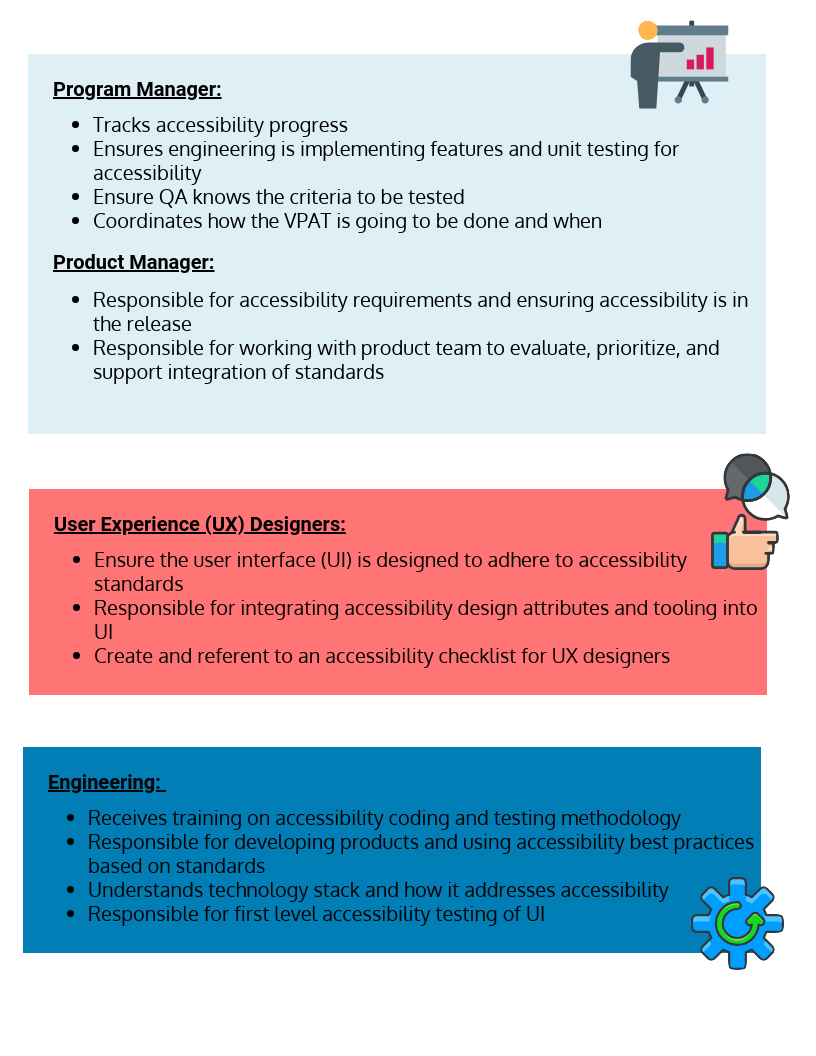Webinar Wrap-Up: Integrating Accessibility into the Development Process
Updated: June 29, 2021
In the webinar entitled “Integrating Accessibility into the Development Process,” Monica Gaines, Accessibility Technical Lead, and Michele Van Doozer, Accessibility Program Manager at Oracle, discuss practical steps for developing accessible ICT products at your organization.
Viewers will leave with a better understanding of the key roles and responsibilities for building an accessibility-minded team, and learn that when accessibility is incorporated from the beginning of product development, you end up with a better product.
Defining an Accessibility Policy
The first step Monica and Michele recommend is to begin defining an accessibility policy at your organization. This will allow you to make sure you get approval from your executive, legal, and management teams.
In addition, you’ll also want to:
- Have guidelines that are WCAG 2.1 compliant
- Ensure testing procedures
- Develop best practices
- Incorporate a bug tracking system
- Provide training
- Communicate important accessibility information
- Use the Voluntary Product Accessibility Template (VPAT)/Accessibility Conformance Report (ACR) Approval Process
Your policy should include applicability and scope. This entails your authoring tools, hardware, documentation, training, developer tools, etc.
You should also include an authority and enforcement section, where you define the successes and failures of your policy.
Lastly, you want to include some kind of grace period. Accessibility doesn’t happen overnight; your team will need time to build it into your new and existing products.
Dedicated Accessibility Sprints
During the development process, you’ll want to break the process into small, incremental builds or sprints. Within each sprint, your product features are going to be described by stories in the voice of the target user. During this process, you’ll want to identify the tasks to be implemented and tested for each sprint.
There are some advantages and disadvantages to having a dedicated accessibility sprint.
Advantages:
- Focus completely on accessibility
- May save implementation time
- Supports accessibility specialists for development and test
- Supports focused system testing for accessibility
Disadvantages
- Accessibility knowledge can be rare among team
- Require an expert to provide guidance on accessibility
Accessibility Standards
When it comes to accessibility, it’s important to know which standards you want to follow and make sure it meets all of your customers’ needs.
Instead of just telling your team to meet the latest WCAG standard or Section 508, Oracle recommends building a checklist for everyone to follow with these laws and standards included.
So what do the checklists look like? Each checklist has information on the accessibility standards and how they impact each tech stack.
- Guideline: the actual text of the standard
- Understanding: contains links to additional information to help with understanding the guideline
- Sample remarks: text that can be used as a starting point to author the VPAT
- Testing techniques: example methods for testing
Accessibility by Role
Accessibility applies to everybody in the organization and everyone should be aware of how important it is. Your policy should be followed by all teams across the company.
Here are different accessibility roles you can implement on your team:
—
In conclusion, in order to successfully incorporate accessibility into all phases of the development process, ensure that the product team understands how accessibility will impact their work and is trained on accessibility.
It’s recommended to start testing early in the testing cycle. This will make sure that you don’t miss anything down the line.
Remember, accessibility is not something that can be done once and forgotten. You want to move forward, not backward. Accessibility is something to continuously improve on during the development process.
Watch the full webinar, Integrating Accessibility into the Development Process, below👇







